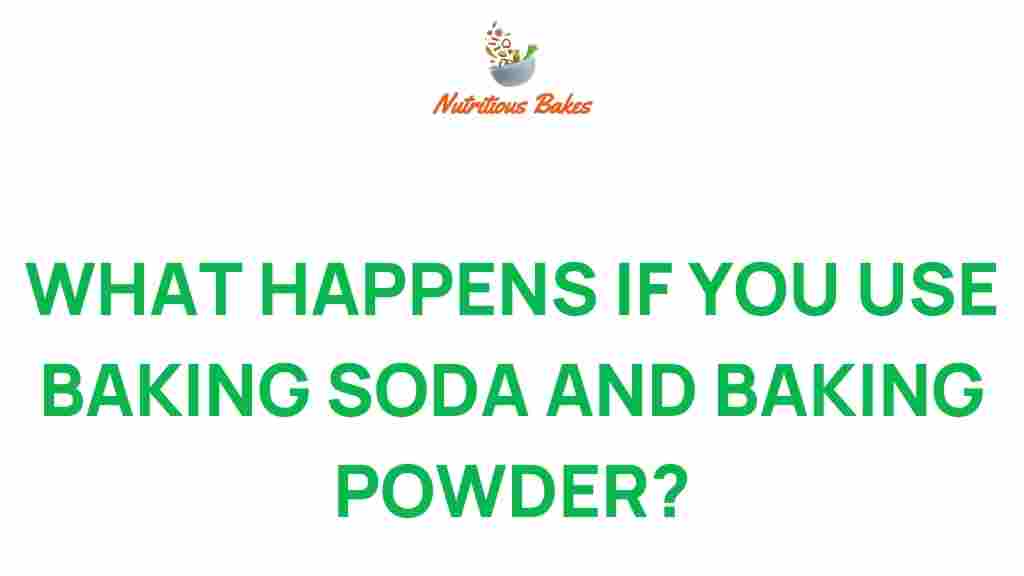The Surprising Effects of Mixing Baking Soda and Baking Powder
When it comes to baking, understanding the role of various ingredients is crucial for achieving recipe success. Among these ingredients, baking soda and baking powder stand out as essential leavening agents. While both serve a similar purpose, they have distinct chemical properties and effects on your baked goods. In this article, we will explore the surprising effects of mixing baking soda and baking powder, delve into the cooking chemistry behind these ingredients, and provide culinary tips to enhance your baking experience.
Understanding Baking Soda and Baking Powder
Before we dive into the effects of mixing these two leavening agents, let’s clarify what baking soda and baking powder are and how they function in cooking chemistry.
- Baking Soda: Also known as sodium bicarbonate, baking soda is a pure chemical compound that requires an acid to activate. When combined with an acid (like vinegar, lemon juice, or yogurt), it produces carbon dioxide gas, which causes dough or batter to rise.
- Baking Powder: Baking powder contains baking soda, but it also includes an acid (usually cream of tartar) and a moisture-absorbing agent. It can be classified into two types: single-acting and double-acting. Double-acting baking powder releases carbon dioxide in two phases: once when wet and again when heated.
The Role of Leavening Agents in Baking
Leavening agents are crucial in baking as they help create a light and airy texture in baked goods. The carbon dioxide produced when baking soda or baking powder is activated creates bubbles in the batter, which expand during baking and result in the desired rise.
Mixing Baking Soda and Baking Powder: What Happens?
Mixing baking soda and baking powder in a recipe can lead to interesting outcomes, depending on the amount used and the ingredients involved. Here are some surprising effects of this combination:
- Enhanced Leavening: When used together, baking soda and baking powder can enhance the leavening effect, producing a fluffier texture in cakes and muffins.
- Flavor Balance: Baking soda can help neutralize acidic flavors in a recipe, while baking powder ensures the rise. This balance can lead to better-tasting baked goods.
- Texture Variations: The combination can result in varying textures. For example, the use of both can create a more tender crumb in cakes.
Step-by-Step Process: How to Use Baking Soda and Baking Powder Together
To successfully incorporate both baking soda and baking powder into your recipes, follow these steps:
- Assess the Recipe: Determine if your recipe requires an acidic ingredient. If it does, you can consider using baking soda. If not, baking powder alone may suffice.
- Choose the Right Ratios: A general guideline is to use 1/4 teaspoon of baking soda for every 1 teaspoon of baking powder. This ensures proper leavening without overpowering the flavor.
- Mix Thoroughly: When combining dry ingredients, mix baking soda and baking powder evenly with flour to ensure consistent rising.
- Incorporate Wet Ingredients: Add the wet ingredients to your dry mixture promptly after mixing. This will activate the leavening agents and maximize their effectiveness.
- Bake Immediately: Once the batter or dough is mixed, transfer it to the oven right away. Delaying can cause the gases to escape, leading to less rise.
Common Culinary Tips for Success
Here are some culinary tips to ensure success when using baking soda and baking powder:
- Check Expiration Dates: Both baking soda and baking powder can lose potency over time. Always check the expiration dates before use.
- Test for Freshness: To test baking soda, add a few drops of vinegar; it should fizz. For baking powder, mix it with warm water; it should bubble vigorously.
- Adjust Based on Ingredients: If your recipe has a lot of acidic ingredients, consider reducing the baking powder, as the baking soda will already provide leavening.
- Practice Precision: Accurate measurements are crucial in baking. Use proper measuring spoons and cups for the best results.
Troubleshooting Common Issues
Even with the best intentions, baking can sometimes go awry. Here are some common issues and how to troubleshoot them:
- Overly Dense Texture: If your baked goods are dense, you may have used too much baking soda. Try reducing the amount or increasing the acidic ingredients in your recipe.
- Excessive Rising: If your baked goods rise too much and then collapse, you may have added too much baking powder. Adjust the amounts in future attempts.
- Bitter Taste: An excess of baking soda can lead to a bitter flavor. Balance it with enough acidic ingredients or reduce the amount used.
Kitchen Experiments: Discovering New Possibilities
Experimenting with baking soda and baking powder can lead to exciting culinary discoveries. Here are a few kitchen experiments you can try:
- Creating Quick Bread: Use both leavening agents in a quick bread recipe to see how the texture changes. Take notes on your results.
- Flavor Variations: Bake the same recipe with different amounts of baking soda and baking powder to taste the differences in flavor and texture.
- Alternative Ingredients: Substitute other acidic ingredients (like buttermilk or sour cream) and observe how they interact with baking soda and baking powder.
For more insights into baking science, you can check out this resource on baking chemistry.
Conclusion
Understanding the surprising effects of mixing baking soda and baking powder opens up a world of possibilities in the kitchen. By mastering the cooking chemistry of these leavening agents, you can enhance the texture and flavor of your baked goods, leading to greater recipe success. Remember to experiment, troubleshoot, and most importantly, enjoy the baking process. For additional tips and recipes, visit our baking blog for more information!
This article is in the category Tips and created by NutritiousBakes Team
